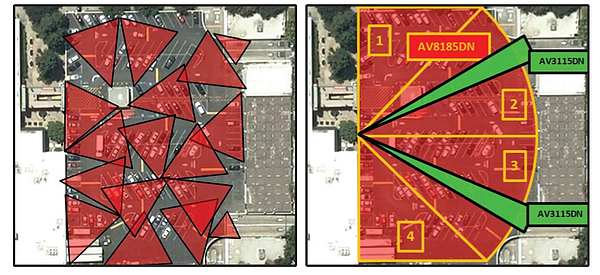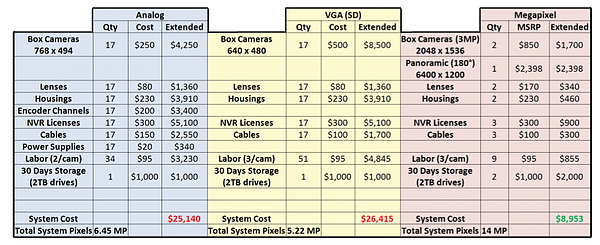When deciding on a system or product, one of the biggest factors involved in the process, if not the most important, is the price. For security and surveillance systems, the pricetag is often the direct correlation to the detail of an image (measured in pixels). From this then, is how one understands that a companies return of investment on security is based on the ability to be able to read license plates and recognize faces. This is the basic breakdown of the number of pixels delivered per dollar spent.

Megapixel cameras provide far superior performance and imaging capabilities versus legacy analog technology and standard-definition IP cameras, as clearly illustrated above. Megapixel cameras are also field-proven to deliver the most cost-effective video surveillance solutions. To understand the real value of megapixel cameras, it’s important to evaluate the total system cost, however, and not simply the price of a single camera.

Megapixel cameras do a far better job of capturing more information than standard-resolution cameras, and that superior performance translates into ROI in several ways. Based on the measurement of “pixels per meter,” (a standard for the number of pixels required to depict one meter of a scene for a specific application) more pixels translate into a larger viewing area. For example, while it could require ten standard- resolution cameras to cover a single parking lot, the same coverage can be delivered using three or four three megapixel cameras or even a single megapixel panoramic camera, depending on the application requirements.
This reduction in the number of cameras translates into a decrease in installation costs and maintenance costs. Furthermore, the ability to digitally zoom into live scenes and recorded video while maintaining high resolution and wide area coverage, virtually eliminates the need for mechanical pan-tilt-zoom (PTZ) devices. By capturing a detailed, wide-angle view without the PTZ camera requirement of having a live operator following events in real-time, multi- megapixel cameras can also deliver a reduced operating costs by eliminating operations staff.

The total cost of the system is a more meaningful measure than the price of a single component. In the case of megapixel cameras, beyond the relative lower resolution-per-dollar cost analysis, other savings include a decrease in amount of devices, licenses, elimination of PTZ systems, and labor required to have all this installed. Using fewer cameras to effectively cover the same area also translates into infrastructure cost savings too (cables, mounts, housings, etc.), which makes it easy to realize an improved ROI.
If you would like to learn more about security and surveillance systems, visit the contact us page to find your closest Accu-Tech security representative, today.


.png?width=58&height=58&name=X_logo_2023_(white).png)
